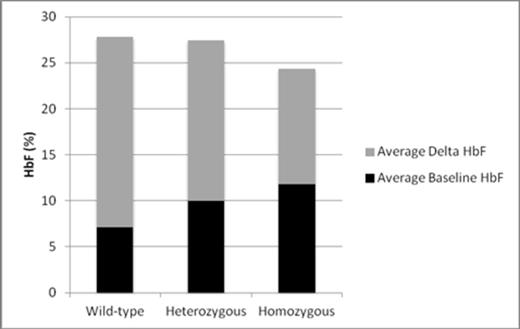Abstract
Hydroxyurea is a safe and effective therapy for sickle cell disease (SCD), with the majority of its benefit correlating with the amount of fetal hemoglobin (HbF) produced at maximum tolerated dose, or MTD. There is substantial individual variability in HbF response to hydroxyurea, with baseline HbF levels accounting for approximately 40% of the observed variability in final HbF at MTD. Several genetic modifiers of baseline, or endogenous, HbF levels have previously been identified by genome wide association studies. These include certain beta-globin haplotypes, and polymorphisms at the BCL11A and HBS1L-MYB gene loci. The effect of these known genetic modifiers of baseline HbF on drug response has been investigated in a small (n=38) cohort of pediatric patients treated with hydroxyurea in several centers with different treatment guidelines. In this limited group, no association was found between the BCL11A or HBS1L-MYB variants and the change in HbF at MTD (ΔHbF; final HbF minus baseline HbF). Co-inheritance of alpha thalassemia has been reported to have a negative effect on HbF response to hydroxyurea. To independently verify these findings in a larger sample size, we tested the effect of four BCL11A single nucleotide polymorphisms (SNPs), three HBS1L-MYB SNPs, the XmnI polymorphism, and co-inheritance of α-thalassemia on ΔHbF at MTD in a cohort of 171 pediatric SCA patients, treated prospectively and uniformly on HUSTLE (NCT NCT00305175) and SWiTCH (NCT 00122980) protocols. These patients represent the most accurate hydroxyurea phenotypes available, as all were meticulously titrated to MTD, and had complete laboratory data demonstrating compliance, such as absolute neutrophil count and absolute reticulocyte count within the therapeutic range. In our cohort, the BCL11A SNPs rs1427407, rs4671393 and rs11886868 were significantly associated with baseline HbF (Table 1). We saw no association between baseline HbF and any of the HBS1L-MYB SNPs, XmnI, α-thalassemia or BCL11A SNP rs7599488. In contrast to other reports, we found that coinheritance of α-thalassemia did not affect hydroxyurea treatment response (p=0.088). We found that BCL11A SNPs rs1427407, rs4671393 and rs11886868 were significantly associated with reduced ΔHbF following hydroxyurea treatment (Table 1), where individuals with the BCL11A SNPs had a smaller ΔHbF compared to individuals without the polymorphisms, as shown by the negative baseline β-value. For example, one BCL11A rs1427407 SNP is associated with a ΔHbF 3.46 percentage points lower than individuals without the SNP at MTD, with an additive, dose effect of the SNP at the second allele; homozygous individuals have higher baseline HbF, lower ΔHbF compared to heterozygotes or wild-type individuals (Figure 1). The other variants HBS1L-MYB SNPs, XmnI, α-thalassemia or BCL11A SNP rs7599488 did not significantly impact ΔHbF. None of the tested polymorphisms, including the BCL11A SNPs, were associated with a significant difference in final HbF levels. Individuals with higher baseline HbF due to BCL11A polymorphisms demonstrate a statistically significant lower rise in HbF in response to hydroxyurea than individuals without these polymorphisms. Identification of more variants associated with baseline and ΔHbF through next generation sequencing will help elucidate whether the negative effect of high baseline on ΔHbF is a BCL11A specific effect, or a manifestation of a general threshold effect, that there is a maximum amount of HbF an individual is able to achieve through hydroxyurea induction.
Close modal
Table 1
Association between BCL11A SNPs and response to hydroxyurea.
| Gene . | SNP ID . | Baseline β-value (lnHbF) . | Baseline p-value . | ΔHbF β-value (%HbF) . | ΔHbF p-value . |
|---|---|---|---|---|---|
| BCL11A | rs1427407 | 0.356 | 9.05x10-5 | -3.46 | 1.02x10-3 |
| BCL11A | rs4671393 | 0.27 | 2.17x10-3 | -2.62 | 7.21x10-3 |
| BCL11A | rs11886868 | 0.13 | 1.61x10-4 | -3.00 | 7.86x10-4 |
| BCL11A | rs7599488 | 0.08 | 0.30 | -0.78 | 0.33 |
| Gene . | SNP ID . | Baseline β-value (lnHbF) . | Baseline p-value . | ΔHbF β-value (%HbF) . | ΔHbF p-value . |
|---|---|---|---|---|---|
| BCL11A | rs1427407 | 0.356 | 9.05x10-5 | -3.46 | 1.02x10-3 |
| BCL11A | rs4671393 | 0.27 | 2.17x10-3 | -2.62 | 7.21x10-3 |
| BCL11A | rs11886868 | 0.13 | 1.61x10-4 | -3.00 | 7.86x10-4 |
| BCL11A | rs7599488 | 0.08 | 0.30 | -0.78 | 0.33 |
Figure 1
Effect of BCL11A rs1427407 on Hydroxyurea Response. Average baseline and ΔHbF values are shown for a sample BCL11A variant.
Figure 1
Effect of BCL11A rs1427407 on Hydroxyurea Response. Average baseline and ΔHbF values are shown for a sample BCL11A variant.
Disclosures:
Off Label Use: Hydroxyurea is not FDA approved for use in pediatric sickle cell patients.
Author notes
*
Asterisk with author names denotes non-ASH members.
© 2013 by The American Society of Hematology
2013


This feature is available to Subscribers Only
Sign In or Create an Account Close Modal